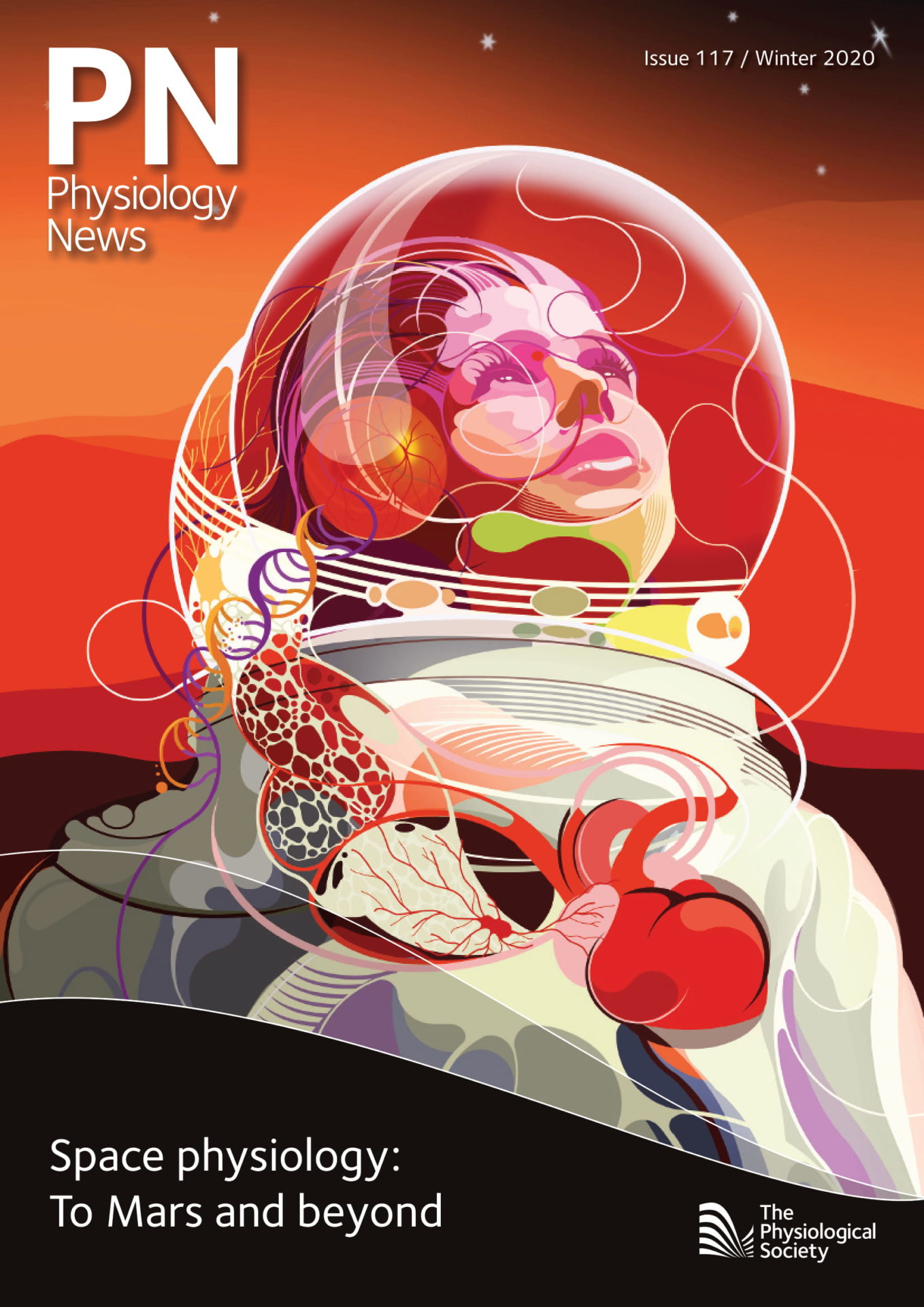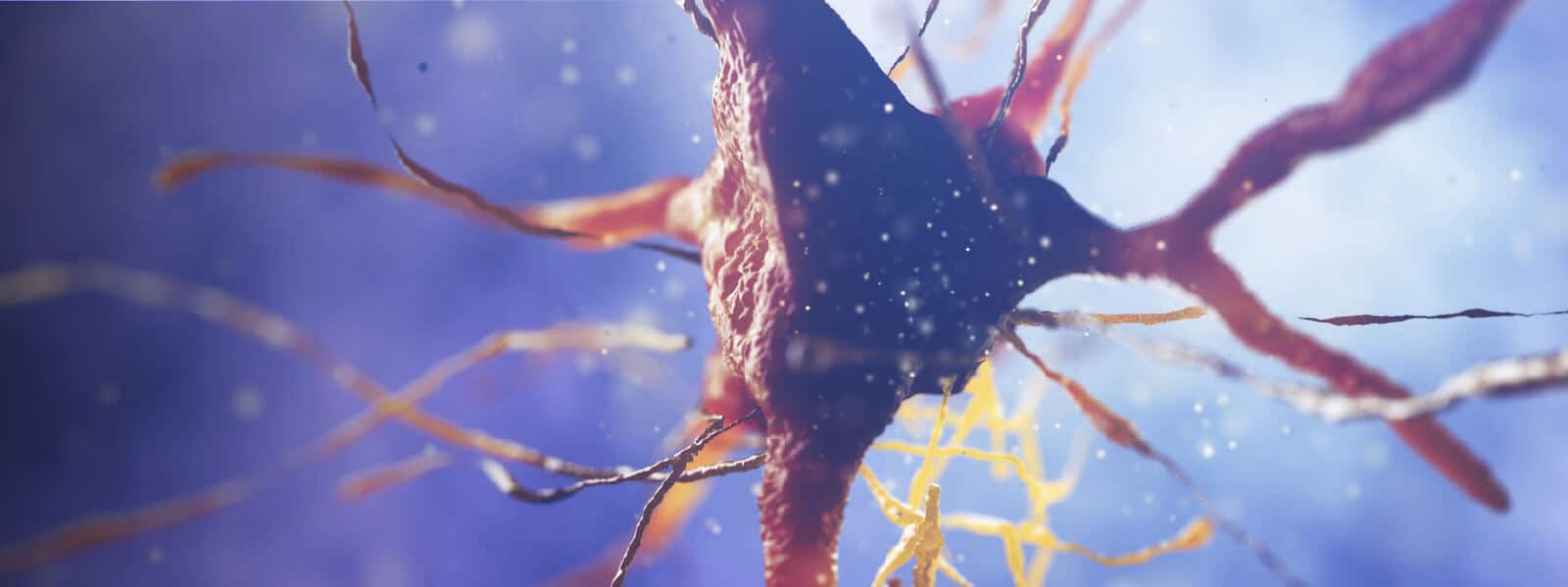
Physiology News Magazine
May the (Gz) force be with you
Gravity and human space exploration
Features
May the (Gz) force be with you
Gravity and human space exploration
Features
Igor Mekjavic
Jozef Stefan Institute, Ljubljana, Slovenia
https://doi.org/10.36866/pn.117.30
Whether discovering how cells sense oxygen and adapt to its availability (a discovery awarded the 2019 Nobel Prize in Physiology or Medicine), or exploring new continents, exploration and discovery are probably among the most exciting human endeavours. How else would Shackleton have assembled a ship’s complement for the Endurance to explore the Antarctic based on the following advertisement (Time, 2003):
“Men wanted for hazardous journey. Small wages, bitter cold, long months of complete darkness, constant danger, safe return doubtful. Honour and recognition in case of success.”
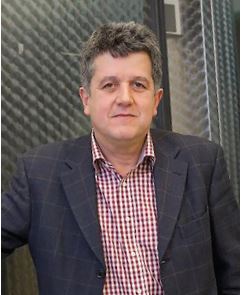
Since Yuri Gagarin’s 108-minute orbital flight in 1961, the investment in space research and technology has allowed us to visit the Moon on several occasions, and in this century to maintain a constant human presence in space aboard one of the most complex structures assembled by an international community of scientists and engineers. This century will witness the establishment of human settlements on the Moon and Mars. The research programme coordinated by the Human and Robotic Exploration section of the European Space Agency explores the many facets of travelling in deep space on human physiological systems. Research in aid of deep space travel and colonisation of Mars should not be viewed from the perspective of the handful of astronauts, who will undertake these missions, but from the potential of harnessing the knowledge to help specific Earth-bound populations. An analogy of the translational nature of life sciences aiding explorers venturing into extreme environments can be found in the work of Scottish physician James Lind (1753), who worked as chief physician of the Royal Naval Hospital at Gosport. He demonstrated that a diet of citrus fruits prevented and cured scurvy, a disease that afflicted sailors exploring the newly discovered continents. His discovery drastically reduced the number of scurvy-associated deaths, not just among the explorers, but also among the general population. Similarly, our current preparations for the exploration of the Moon and Mars can only continue unimpaired with an understanding of the effects of space travel on physiological systems, and with the development of suitable measures and strategies to counter the pathophysiological consequences of prolonged space travel that may ultimately lead to the colonisation of the Moon and Mars.
Withdrawal of the head-to-foot gravitational vector (Gz) induces adaptations in all physiological systems (i.e. loss of skeletal muscle mass, bone demineralisation, haemodynamic changes, etc.) (see Norsk p. 40; Rittweger, Frings-Meuthen, 2013; McDonnell et al., 2019). Safe return to Earth’s gravitational field relies on the prevention of these potentially harmful adaptations. The initial focus of space physiology research has been understanding the process of microgravity-induced adaptations, and this has been followed by research investigating mitigating strategies (i.e. exercise, nutrition, etc.). Establishment of a permanent presence on the Moon and Mars will, for logistical reasons, require that the internal environment of habitats be hypobaric and hypoxic (as discussed later in the text). As a consequence, one focus of Space Life Sciences research has been on the effect of hypoxia on the microgravity-induced adaptations observed in normobaric normoxia.
Despite the many countermeasures developed to prevent adaptation to micro- (during space travel and sojourns on the International Space Station) and reduced- (during sojourns on the Moon and Mars) gravity, it is now apparent that intermittent exposure of astronauts to artificial gravity might be the most efficient solution for maintaining their health and well-being, and ensuring a safe return to Earth as suggested by Herman Noordung 90 years ago (Noordung, 1929). Regarding this, the ESA has established a 5-year research programme to investigate the manner in which artificial gravity (using short-arm human centrifuges) can be employed in mitigating maladaptation to microgravity.
Earth analogues
Parabolic flights
Despite the limited opportunities to conduct experiments in space, Space Life Sciences have been able to progress due to the many ground (Earth)-based research facilities that offer valid simulations of the effects of microgravity on human physiological systems. The most well known of these facilities are the parabolic flights (Fig. 1), which offer up to approximately 20 seconds of microgravity (although this varies depending on the flight pattern). The “vomit comet”, as it used to be called prior to the introduction of pre-flight anti-motion-sickness medication, conducts parabolas whereby the Airbus “laboratory” ascends from 6,000 m to 8,500 m and back again, conducting this several times in succession. During the zenith of the parabolas passengers experience brief periods of microgravity during which they can conduct their experiments. During the nadirs of the parabolas, there is an increase in the gravitational force. By altering the angle of attack of the flight pattern (i.e. parabolas) the flight can also simulate Mars (38% Earth’s gravity) and Moon (17% Earth’s gravity) gravity. This may be sufficient to examine some acute effects of microgravity and reduced gravity, but certainly not sufficient to gain insight into the effects of prolonged exposure to microgravity.
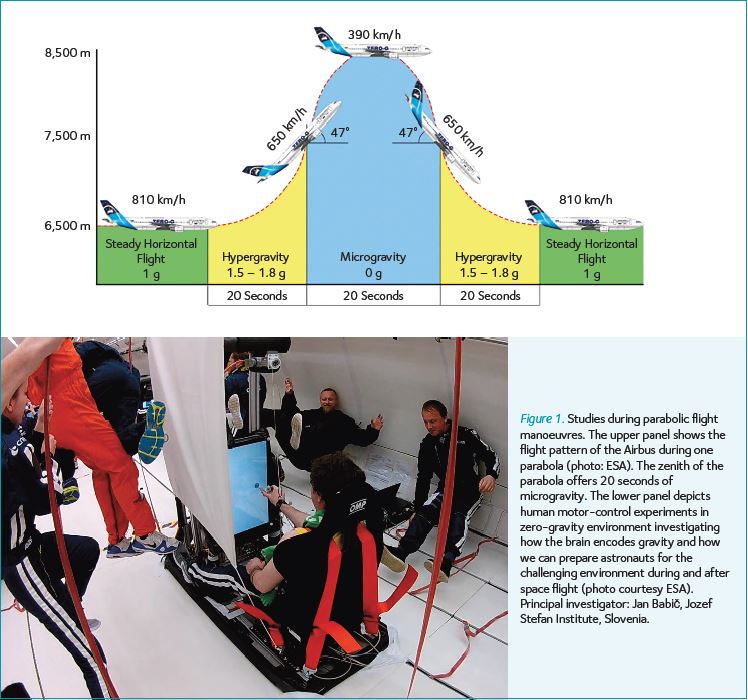
Bed rest experimental model
As astronauts continued to extend their sojourns in space, the adaptations to weightlessness became more apparent. As in other extreme environments, such as heat and altitude, all physiological systems were observed to adapt to the 0 G environment, but the kinetics of the adaptation varied. The adaptations to weightlessness were very similar to the adaptations observed in healthy adults rendered inactive and confined to bed for the same duration (Sandler and Vernikos, 1986). Thus was born the bed rest experimental model, which could be used on Earth to study the process of adaptation of physiological systems to microgravity. In these studies, subjects are rendered inactive and their weight-bearing limbs unloaded by confining them to horizontal bed rest for extended periods (up to several months). To increase the fidelity of the Earth-based analogue, and make life more interesting for the subjects, some bed rests are performed with the head in the -6° head-down tilt, as this causes a headward shift of body fluids, giving rise to the appearance of a “puffy face”, as seen in astronauts. In Europe, bed rest facilities supported by ESA are the Institut Médecine Physiologie Spatiale – MEDES (Toulouse, France), Deutsches Zentrum für Luft- und Raumfahrt – DLR (Koln, Germany), and Olympic Sport Centre Planica – PlanHab (Rateče, Planica).
Concordia Antarctic Research Station
A major issue in spaceflight is the extended confinement in small quarters which need to be shared by the entire crew. Such conditions place a large strain on the psychological status of the crew members. This strain is not so evident in the bed rest models, as there is constant interaction with the medical staff and researchers. As a consequence, ESA has partnered with the Italian (Programma Nazionale di Ricerche in Antartide) and French (Institut polaire français Paul-Émile Victor) research facility Concordia Antarctic Research Station. Scientists now have access to the volunteers within the over-winter crews to study their health and well-being during their one-year assignments at the station.
Planetary habitats
The Concordia Antarctic Research Station is situated at an altitude of 3,200 m, which introduces the element of hypoxia in all observations. This has proven to be a favourable coincidence, as hypobaric and hypoxic environments are now being considered within future planetary habitats (and possibly vehicles). The main reason for this new strategy in the design of habitats is the concern regarding the potential deleterious effect of frequent decompression procedures required when exiting a normobaric habitat. To prevent decompression sickness during current extravehicular activities (EVAs), as a result of the transfer from the 1 ATA environment of the International Space Station to the pressure within the space suit (about
1/3 of an atmosphere), the astronauts prebreathe oxygen during a slow and gradual decompression, a procedure that requires several hours and the assistance of the remaining crew. This protocol is logistically not practical, and by maintaining a hypobaric environment, the astronauts will be able to transfer from within the habitats to the suit without the need for lengthy and complex decompression procedures. However, hypoxia induced by such a hypobaric environment will be too severe, and the fraction of oxygen may be elevated to prevent the deleterious effects of hypoxia at such a simulated altitude. It is envisaged that the partial pressure of oxygen within the habitats will be equivalent to altitudes between 3,000 m and 4,000 m. As a result of this development, recent research at the Planica facility in Slovenia (Olympic Sport Centre Planica) has focused on the issue of the manner in which hypoxia affects the process of adaptation of physiological systems to bed rest (Fig. 2). To date, all other bed rest studies have been conducted in normoxic environments, whereas the ongoing bed rest studies in Planica have examined these processes in hypoxia. As would be anticipated, there are benefits of adaptation to a hypoxic environment in some responses, and not so in others.
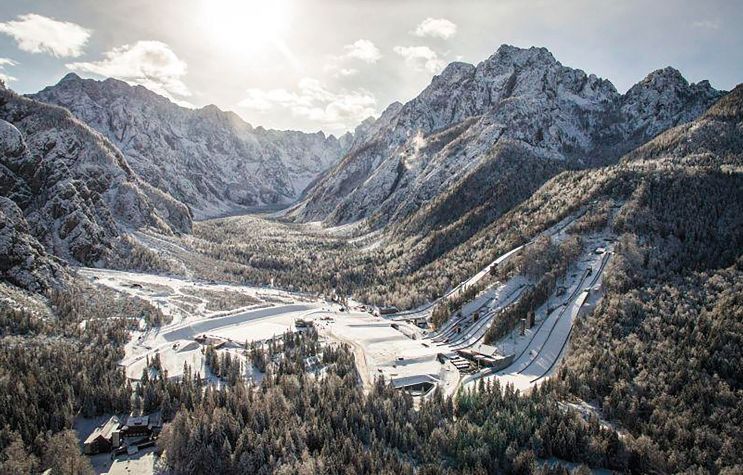
Countermeasures
A major cornerstone of Space Life Sciences research is the development and assessment of measures that would counteract the cardiorespiratory, musculoskeletal, neurohumoral, etc., adaptation to microgravity. As a consequence of these efforts resulting from ground-based (bed rest) studies, astronauts have a comprehensive schedule of resistance training and aerobic exercise, coupled with a regulated diet. Despite the relative success of these countermeasures, ESA is considering implementing short-arm human centrifuges on board vehicles on deep space missions to provide astronauts with intermittent and short-term artificial gravity. A programme of research opportunities will be announced by ESA shortly, to focus on the efficacy of artificial gravity, or rather the optimal exposure to a gravitational load in order to prevent the microgravity-induced adaptations. The previously mentioned ESA ground-based facilities in Toulouse (MEDES, France), Koln (DLR; Germany) and Planica (Olympic Sport Centre Planica, Slovenia) will host 60-day bed rests investigating the efficacy of artificial gravity in combination with exercise, nutritional strategies and hypoxia in mitigating inactivity/unloading-induced changes to the physiological systems (Fig. 3).
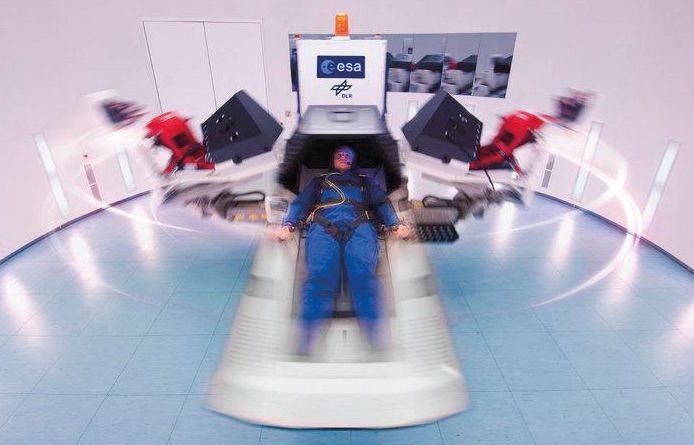
Of the many factors that influence the health and well-being of astronauts during space travel, and will impact on them during their life on the Moon and Mars, two critical areas remain unresolved. The first is the effect of solar and galactic cosmic radiation (see Limoli p. 26; Whittaker p. 36). This will most likely need to be resolved with appropriate shielding (underground habitats perhaps). The second is the unexplained loss of vision in astronauts exposed to microgravity for prolonged periods, which has been termed Spaceflight-associated neuro-ocular syndrome (SANS) (see Lawley and Levine p. 22). It is most likely attributed to the increase in intracranial pressure, which impacts the intraocular pressure, causing morphological and functional changes in the eye. Ongoing experiments in our laboratory suggest that the resistance exercise coupled with the hypercapnic environment (due to inefficient capacity of the CO2 scrubbers, the fraction of CO2 may be 15 to 20 times that on Earth) of the ISS may contribute to the aetiology of SANS (Fig. 4).
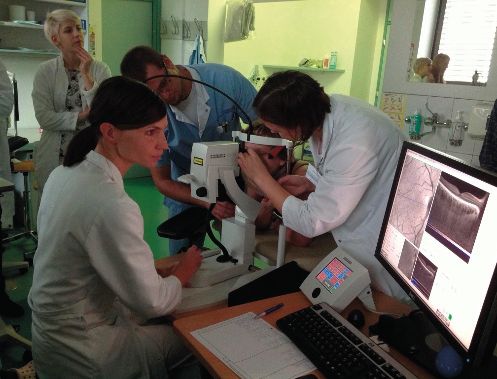
Life science on Earth for life in space (and on the Moon and Mars)
The principal aim of ESA is to support science in space in support of humans on Earth (Life in Space for life on Earth). However, our research endeavours on Earth are not only crucial for our continued exploration of space, but will also be of relevance to specific populations on Earth.
The current lifestyle of a significant portion of the population in Western societies favours inactivity, which is often coupled with unloading of the lower limbs. The similarity between this and the bed rest exposure is obvious, and the consequences are similar. The difference is that the subjects in bed rest may revert to a more active lifestyle once the experiment is complete. These studies have catalogued the rate of change in the structure and function of physiological systems, and extrapolation of the results to a younger population with inactive lifestyles yields alarming predictions. Based on her experience in coordinating Life Sciences studies at NASA, Joan Vernikos (2011) coined the phrase Gravity deprivation syndrome, to encompass all of the detrimental effects of an inactive lifestyle, resulting in a reduction/elimination of the head-to-foot gravitational force (Gz).
Recent bed rest studies confining healthy individuals to inactivity and hypoxia provide insight into illnesses which render the patient similarly inactive and hypoxic, such as chronic obstructive pulmonary disease. The importance of such studies was elegantly summarised by Harriet Tuckey in her biography of her father (Tuckey, 2013), one of the most prominent Extreme Environment physiologists, Griffith Pugh:
“Lowland people suffering from chronic illnesses such as heart disease, bronchitis, and emphysema lived with long-term deprivation of oxygen. Lacking a comprehensive understanding of what happens to the healthy body when deprived of oxygen over a long period, it was hard for physicians to distinguish which of their symptoms were caused by their bodies adapting – ‘acclimatising’ – to the shortage of oxygen and which were the direct result of their illnesses. Anaesthetists handling patients in intensive care also required a better understanding of the impact of oxygen lack on the healthy body, as did engineers designing pressurisation and oxygen equipment for high-flying aircraft and space capsules.”
The physiological aspects of crew selection
We tend to report the physiological responses of subjects exposed to an experimental intervention, such as bed rest, as averages with standard deviations from the mean. A requirement necessitated by the ability to compare the effect of these responses with statistical procedures. “Outliers” and “non-responders” are normally the bane of many theses and reports. Understanding such individual variability in physiological responses has now sparked researchers to gain a better understanding of the magnitude of anticipated variability and the source of such variability (Atkinson and Batterham, 2015). ESA has tasked a consortium of physiologists to investigate individual variability of the physiological responses to bed rest to better understand why some individuals are more resilient to the effect of inactivity/unloading than others1. This knowledge will be of benefit in determining crew members for prolonged space flights, since it would allow choosing candidates who would exhibit a lesser degree of musculoskeletal atrophy and cardiovascular deconditioning. This knowledge is the basis of the new field of personalised medicine.
As with the pioneering work of Lind, Space Life Sciences research may be initiated to support human exploration, but the results of the discoveries will aid many Earth-bound populations (particularly those suffering from sarcopenia, osteoporosis, inactivity, hypoxia, etc.). This century will introduce a new era of human space exploration, the success of which will, to a large degree, depend on upcoming generations of physiologists.
1ESA Contract No. 4000124642/18/NL/PG/gm: Individual variation in human responses to prolonged bed rest in Slovene bed rest programme.
References
Atkinson G, Batterham AM (2015). True and false interindividual differences in the physiological response to an intervention. Experimental Physiology 100(6), 577 – 588. DOI: 10.1113/EP085070
Lind J (1753). A Treatise of the Scurvy in Three Parts. Containing an Inquiry into the Nature, Causes, and Cure, of that Disease; Together with a Critical and Chronological View of what has been published on the Subject. 1st ed. Edinburgh: A. Kincaid and A. Donaldson. DOI: 10.1017/CBO9781107256644
McDonnell AC et al. (2019). The LunHab project: Muscle and bone alterations in male participants following a 10 day lunar habitat simulation. Exp Physiol 104, 1250 – 1261. DOI: 10.1113/EP087482
Noordung H (1929). Das Problem der Befahrung des Weltraums. Berlin: Richard Carl Schmidt & Co.
Rittweger J, Frings-Meuthen P (2013). Bone loss in microgravity. Physiology News 92, 38 – 41. DOI: 10.36866/pn.92.38
Sandler H, Vernikos J (1986). Inactivity: Physiological effects. Orlando, FL (USA): Academic Press Inc. DOI: 10.1016/b978-0-12-618510-2.x5001-5
Time (2003). The Great Survivor: Ernest Shackleton. [Online] Time. Available at: http://content.time.com/time/specials/packages/
Tuckey H (2013). Everest. The First Ascent. The Untold Story of Griffith Pugh, the Man who made it Possible. London, UK: Random House Group Ltd.
Vernikos J (2011). Sitting Kills, Moving Heals. How Simple Everyday Movement will Prevent Pain, Illness, and Early Death – and Exercise Alone Won’t. Fresno, CA (USA): Quill Driver Books.
